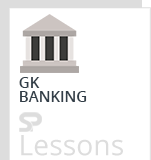 Introduction
Introduction
What is meant by Financial Awareness? Financial awareness foundation is financial literacy, which is defined as The ability to use knowledge and skills to effectively manage financial resources efficiently at a personal level and through the life cycle. Financial Awareness is a section that is present in most of the banking competitive exams. Candidates planning to take up employment in the banking sector must be aware of many of the terms policies and other such important information related with financial awareness. The article Financial Awareness Quiz 29 provides quiz sets useful to the candidates while preparing Various Banking & Government Exams like IBPS RRB, SBI PO, SBI Clerk, SSC CPO, SSC CHSL. Financial Awareness Quiz 29
 Quiz
Quiz
1. Pradhan Mantri Vaya Vandana Yojana (PMVVY)’ aims to provide social security during old age. What is the minimum purchase price under the scheme for a minimum pension of Rs. 1,000/- per month?
-
A. Rs.1,20,000
B. Rs.1,00,000
C. Rs.1,25,000
D. Rs.1,50,000
E. Rs. 2,50,000
-
A. Financial risk
B. Currency risk
C. Investment risk
D. Market and finance risk
E. Market risk
-
A. Put Option
B. European Option
C. Call Option
D. American Option
E. None of the above
-
A. Slate Cheque
B. Anti-dated cheque
C. Bearer Cheque
D. Blank cheque
E. Order Cheque
-
A. Informal banking
B. Indigenous banking
C. Shadow banking
D. Development banking
E. Adaptive Banking
1. “Shishu” scheme under ‘PradhanMantri Mudra Yojana’ covers loan upto which limit?
-
A. Rs. 100,000
B. Rs. 50,000
C. Rs. 500,000
D. Rs. 200,000
E. Rs. 250,000
-
A. 6.50% and 19.50%
B. 6.25% and 19.25%
C. 6.75% and 19.75%
D. 6.50% and 19.25%
E. 5.75% and 18.50%
-
A. Madhya Pradesh
B. West Bengal
C. Bihar
D. Uttarakhand
E. Assam
-
A. Rs. 25 Lakh
B. Rs. 10 Lakh
C. Rs. 30 Lakh
D. Rs. 5 Lakh
E. Rs. 20 Lakh
-
A. Rs. 25
B. Rs. 50
C. Rs. 100
D. Rs. 75
E. Rs. 150
1. Which among the following is a condition of slow economic growth and relatively high unemployment?
-
A. Deflation
B. Bottleneck Inflation
C. Stagflation
D. Reflation
E. Creeping Inflation
-
A. 60 days
B. 180 days
C. 30 days
D. 45 days
E. 90 days
-
A. 5 years
B. 10 years
C. 3 years
D. 15 years
E. 8 years
-
A. 7.3%
B. 7.5%
C. 7.2%
D. 7.6%
E. 7.8%
-
A. M1
B. M0
C. M2
D. M3
E. M4



